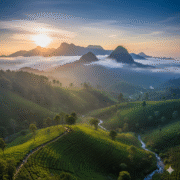
Sri Lanka’s UNESCO World Heritage Sites: A Tapestry of Diversity in Small Island
- November 13, 2025
- eunoialankatours
- 6:45 pm
Sri Lanka is a jewel of the Indian Ocean—an island just 65,610 square kilometers in size, yet it holds an extraordinary richness that many larger countries cannot match. Within this compact landmass, you can journey through 8 UNESCO World Heritage Sites, each reflecting a unique chapter of history, culture, faith, or nature.
At Eunoia Lanka Tours, our guiding philosophy—“Wonder of Diversification and Feel like a Local”—comes alive in these sites. Nowhere else does such a small island present such a profound mosaic of diversity.
🏛️ The Ancient Capitals & Sacred Sites
1. Anuradhapura – The Sacred City of Beginnings
One of the oldest continuously inhabited cities in the world, Anuradhapura was the first capital of Sri Lanka and a thriving center of Buddhism. Home to the Sri Maha Bodhi Tree—grown from a cutting of the tree under which the Buddha attained enlightenment—its towering stupas and monastic ruins remind us of over two millennia of spiritual devotion.
2. Polonnaruwa – A Medieval Masterpiece
The medieval capital Polonnaruwa carries echoes of regal glory, with the Gal Vihara’s granite Buddhas, vast reservoirs, and palace ruins that illustrate both Buddhist artistry and hydraulic engineering brilliance. It is a city where the spiritual and practical blended seamlessly.
3. Sigiriya – The Lion Rock Fortress – Palace in the Sky
Rising nearly 200 meters above the plains, Sigiriya is one of the most dramatic UNESCO sites in Asia. Built in the 5th century by King Kashyapa, this rock citadel dazzles with frescoes, landscaped water gardens, and mirror walls. Part royal palace, part fortress, part art gallery—Sigiriya is a masterpiece of imagination and urban planning.
4. Dambulla Cave Temple – A Gallery in Stone
With over 150 Buddha statues and murals spanning 2,000 square meters, the Dambulla Cave Temple is Sri Lanka’s largest and best-preserved cave-temple complex. Every chamber tells stories of faith and artistry, painted and carved into rock over centuries.
5. Kandy and the Temple of the Tooth – The Heart of Tradition
The hill capital of Kandy is not only picturesque but also spiritually profound. Its most sacred site, the Temple of the Sacred Tooth Relic, enshrines a relic of the Buddha and remains a living center of worship. The annual Esala Perahera festival—filled with dancers, drummers, and decorated elephants—keeps alive centuries of cultural tradition.
🌍 The Natural and Colonial Legacies
6. Galle Fort – A Coastal Chronicle of Empires
On the southern coast, Galle Fort tells the story of colonial encounters. Originally built by the Portuguese and later fortified by the Dutch and British, it is today a bustling town within ancient ramparts. Narrow streets lined with churches, mosques, boutique cafés, and art galleries reveal a living blend of European and Sri Lankan culture.
7. Sinharaja Rainforest – A Living Museum of Nature
A UNESCO Biosphere Reserve, Sinharaja is Sri Lanka’s last viable tropical rainforest. Over 50% of the island’s endemic species—from birds and butterflies to trees and reptiles—are found here. To walk its trails is to witness evolution at work, a living museum where every sound and shade speaks of biodiversity.
8. Central Highlands – Cloud Forests and Misty Peaks
The Central Highlands, including Horton Plains, the Knuckles Range, and Peak Wilderness, represent Sri Lanka’s montane beauty. Hiking here reveals cloud forests, alpine meadows, and waterfalls. It is also home to rare species such as the purple-faced langur and the Sri Lankan leopard, making it a haven for nature lovers.
One Island, Infinite Stories
What makes Sri Lanka remarkable is not just that these eight UNESCO sites exist, but that they do so within such a small island. In less than a day’s travel, you can move from an ancient Buddhist city to a colonial fort, from rainforest to tea-clad highlands.
- Four sites—Anuradhapura, Polonnaruwa, Dambulla, and Kandy—celebrate Buddhism’s enduring influence.
- Sigiriya highlights ancient creativity and urban sophistication.
- Galle Fort echoes with Portuguese, Dutch, and British legacies.
- Sinharaja and the Central Highlands showcase Sri Lanka’s astonishing biodiversity.
This breathtaking variation is what we at Eunoia Lanka Tours call the “Wonder of Diversification.” And when you travel with us, you don’t just see these places—you feel like a local, engaging with the culture, spirituality, and everyday life that make Sri Lanka truly unique.
Sri Lanka may be small in size, but it is vast in experience. Its UNESCO World Heritage Sites are the windows to understanding how diversity—cultural, historical, and natural—creates richness beyond measure.


